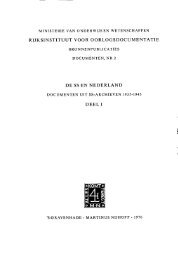De razzia van Rotterdam. 10-11 november 1944 - KNAW
De razzia van Rotterdam. 10-11 november 1944 - KNAW
De razzia van Rotterdam. 10-11 november 1944 - KNAW
Create successful ePaper yourself
Turn your PDF publications into a flip-book with our unique Google optimized e-Paper software.
SUMMARY 267<br />
BACKGROUND OF THE RAZZIA<br />
<strong>Rotterdam</strong>, second biggest town of Holland suffered many blows during the German<br />
occupation. On May 14, 1940, the city was heavily bombed by the Germans.<br />
Over a thousand people were killed, seventy thousand dwellings were destroyed and<br />
the town’s centre area was razed to the ground.<br />
Fighting had been expected by the population, but not this form of murder. With<br />
these outrageous attack on the defenceless city the people realised that the Germans<br />
would refrain from nothing if their victory was endangered. This lesson was rubbed<br />
into them every day by the ruins and the empty spaces of their own town. Thus, the<br />
bombing of <strong>Rotterdam</strong> had important psychological consequences. It was clear that<br />
any resistance would be mercilessly crushed. This was the basis for successful German<br />
terror.<br />
In August 1942 after an attempt to blow up a German train five hostages, three<br />
of them citizens of <strong>Rotterdam</strong>, were shot by the Germans. When during the last days<br />
of April 1943 large-scale strikes occurred throughout the Netherlands, many German<br />
troops were concentrated in <strong>Rotterdam</strong>. Clearly the Germans attached particular<br />
value to the prevention of unrest in this town which had been made an important<br />
base for the German navy. For this reason <strong>Rotterdam</strong> was bombed regularly by the<br />
Allied Air Forces. Up to November <strong>1944</strong> 21 Allied air attacks had been carried out<br />
in which about 750 people lost their lives. By the end of October <strong>1944</strong> about one<br />
sixth of the population had lost their homes.<br />
When the German armies made their quick withdrawal in western Europe in<br />
September <strong>1944</strong> the harbour installations of <strong>Rotterdam</strong> were destroyed in order to<br />
prevent them being used by the Allied armies. This destruction took place on<br />
September 25, 26, 27. It had a most depressing influence on the population. People<br />
saw the basis of their existence disappear in smoke and ruins. In the part of the<br />
town nearest the harbour a further five thousand people lost their homes. German<br />
terror increased in ferocity. Shootings took place, several houses were burned down.<br />
The military situation did offer no hope of a speedy liberation. This was doubly<br />
disappointing as in the first week of September liberation had seemed at hand. When<br />
the city was silent people could hear the guns firing in the southsrn province of North<br />
Brabant. It was clear however that the Germans were effectively delaying the ad<strong>van</strong>ce<br />
of the Allied troops.<br />
When these troops were fighting in France and Belgium they had received important<br />
assistance from the underground organisations. On September 5, <strong>1944</strong>, “Crazy<br />
Tuesday”, when the people of Holland believed liberation to be imminent, many<br />
anti-German demonstrations had taken place. The Germans had no illusions as to<br />
what would happen if the population could act in cooperation with the Allied armies<br />
and the resistance movement which was believed to have received considerable<br />
supplies of arms. On September 4, <strong>1944</strong>, General Dwight D. Eisenhower, Allied<br />
Supreme Commander, had called upon the people of <strong>Rotterdam</strong> to prevent the






